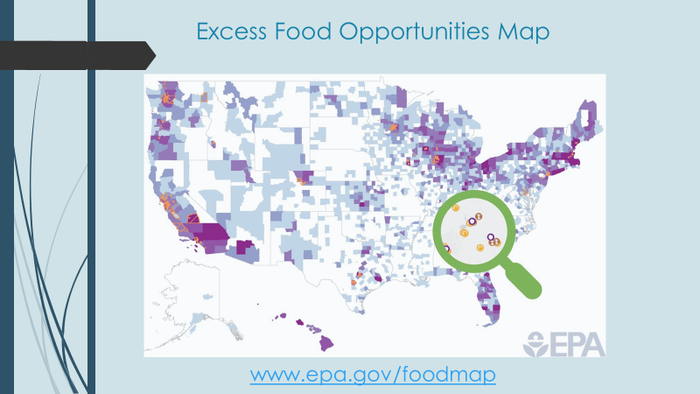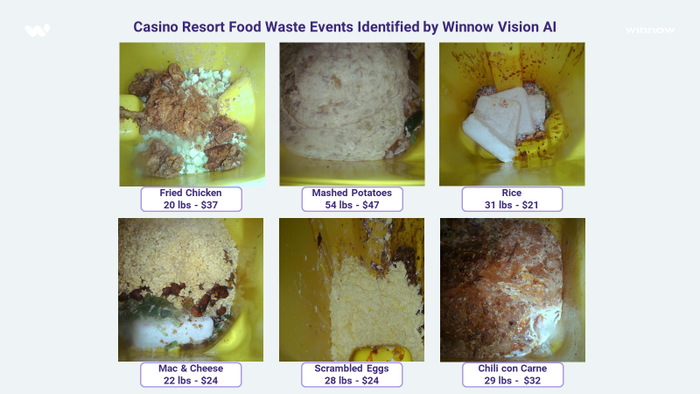September 17, 2020

The idea of tackling the nationwide problem of food waste can be overwhelming and has many people asking how they can help and what can they do? During the Waste360 Food Recovery Forum online on Tuesday, September 15, several industry experts were there to help provide some answers.
In the session, Advances in Wasted Food Policy and Practices; Using Measurement Tools to Reduce Food Waste and Drive Prevention, representatives from the Natural Resource Defense Council (NRDC), the U.S. Environmental Protection Agency (EPA), Leanpath, and Winnow all share different ways to measure food waste and increase prevention.
Darby Hoover, Senior Resources Specialist at NRDC, has been working with her team on several projects to raise awareness around food waste and now the NRDC has templates and tools to turn that awareness into action at the city level.
“Our research led us to identify cities as key partners in addressing food waste. We think cities across the U.S. are often ideally motivated and positioned to address wasted food for several reasons,” said Hoover.
“First, cities are typically responsible for providing solid waste services including infrastructure and financing of waste systems and food waste represents typically the largest component of disposed municipal waste in cities and across the U.S. Most cities grapple with food insecurity among some of their populations and can benefit from expanding efforts to redirect food surpluses to people in need and more and more cities have zero waste, climate, sustainability or other types of goals where reducing food waste can really help address those goals, and finally cities are anxious to learn from their peers and perhaps even outdo them in adopting food waste strategies,” said Hoover.
“Cities also share common barriers when it comes to food waste and waste in general which is typically an access to basic data about how much food is going to waste and the characteristics of that food, a lack of capacity often they unlimited financial and other resources to address this issue and they often don't know where to start,” she said which is why the NRDC has put together a suite of guides and tools designed to help cities chart a path toward reducing food waste.
Hoover goes on to explain in more detail how the Policy and Program Toolkit provides a framework for cities to develop their own food waste strategy that’s organized into four sections and implemented from the top down – rethink, reduce, rescue, and recycle. From there they went on to create a set of “templatized tools for cities use to implement these strategies,” she said. The Food Matters tools provide more guidance and implementation details on many of the strategies outlined in the toolkit based on implementation in model-cities.
Tools include: Food Waste Strategic Communications and Partnership Guide, Increasing Public Awareness About Food Waste Prevention Guide, Food Waste Restaurant Challenge Guide, and more.

NRDC launched its Food Matters website to serve as a centralized resource to help cities take action on food waste. This is where the templates, toolkits and more can be found, said Hoover. She encourages everyone to visit the website to check out the full suite.
NRDC isn’t the only organization to provide tools and guides for helping reduce food waste.
“Improving measurement of wasted food in the United States has been a top priority for EPA for several years,” said Claudia Fabiano of the EPA. She discusses how the EPA’s improving its own methodology for estimating how much wasted food is generated in the U.S. and for estimating how that food is managed by various methods.
“The EPA began working to expand our national measurement methodology a few years ago recognizing that we need more accurate national estimates. The new enhanced methodology expands on our previous work by covering more potential generators of wasted food and by including several additional methods in which wasted food is being handled in order to fully capture how food is flowing through the system in the United States,” said Fabiano.
“We looked at post-harvest wasted food which includes the industrial, commercial, residential, and institutional sectors, so on-farm loss is not included. We estimated by sector how much food waste is being sent to eight different management pathways or destinations which are animal feed, bio based materials and biochemical processing which includes rendering, anerobic digestion, composting, controlled combustion, land application, landfill, and sewer wastewater treatment,” she said. “We use the food loss and waste reporting standard destinations and we also estimated how much access food is being donated to food banks in the U.S. This new methodology will be used for EPA's national estimates included in the annual report entitled: Advancing Sustainable Materials Management Facts and Figures, beginning with the 2018 estimates that will be published later this year.”
Fabiano said the new methodology results in detailed estimates and provides a much more granular look at how food waste flows through the system. She said this new level of detail is a new feature of EPA’s food measurement work and will help those working to reduce wasted food better understand current practices and opportunities.
The updated methodology was published in the EPA’s scoping memo that was released in July 2020, she said.
Other tools the EPA has to measure wasted food and find out where it comes from includes the Excess Food Opportunities Map that’s been updated to version 2.1 and contains nearly 1.2 million generators of excess food such as restaurants, grocery stores, hotels, and hospitals. It also shows food banks, composting and anaerobic digestion facilities as well as communities with source separating organics programs. Fabiano said they are currently working on adding more food banks and pantries so the map can be more useful to those working to donate or recover excess food in their communities.

Fabiano said the EPA is also working with the Commission for Environmental Cooperation and sister agencies in Canada and Mexico to provide helpful resources for measurement. Last year CEC published a practical guide called Why and How to Measure Food Loss and Waste.
“This guide includes easy to use measurement guidelines for every segment of the food supply chain from primary production to manufacturing to the food service industry. this year we're working with the CDC and partners across the food supply chain in all three countries to pilot test the guide, showcase best practices in measurement and food waste reduction and of all additional measurement tools to help businesses institutions and governments,” she said.
Steve Finn, vice president of food waste prevention for Leanpath, said his company’s mission is to make food waste prevention and measurement everyday practice in the world’s kitchens.
“At Leanpath we recognize that the idea of preventing something from occurring can be somewhat intangible so we make food waste visible through tracking, measurement and data. We do this by establishing a baseline level of waste then implementing our measurement focus tools and analytics platform combined with our coaching process to reduce waste in the short term and prevent its recurrence in the long term. We change kitchen culture to maintain that behavior so in short we help food service organizations capture the value in prevention ,” said Finn.
“Food service organizations preventing the occurrence of food waste is always been critically important since four to 10 percent of food service purchases are wasted so when you think about that, on a $1,000,000 in food spend, a single operation could be wasting up to $100,000. The uncertainty and higher costs run by COVID-19 make operating efficiently and reducing waste more important than ever,” said Finn.
He focused a lot of his presentation on the current state of the industry regarding COVID-19’s impact.
“Now that I’ve painted a short picture of how we address food waste prevention, let's take this back to COVID-19 because at this point I would rather talk more about our efforts to address the criticality of the pandemic in the linkage to food waste,” said Finn. “Coming into 2020 we were naturally excited to work with our client partners to drive further progress toward global food waste reduction. After all, this is the decade of action where we're all looking to make the big leap from awareness and education of the past decade to a new decade defined by action and urgency. And while we’re completely committed to expanding tracking in food service operations, COVID has of course led to some immediate adjustments leading us to quickly elevate educational and planning efforts for example.”
Finn said Leanpath assisted with shutdowns, tracking food discards and donations, identifying site needs, sharing food waste prevention best practices on its blog and supporting food service superheroes. He said they’ve also hosted webinars and published several posts with updated training resources for foodservice operations to use while navigating through different state guidelines and plans for reopening.

“To wrap up it's important to note that reducing food waste really matters. Food is central to our lives, it's central to the sustainable development goals, it’s the biggest lever that we have to positively impact climate and human health. So, food waste is a critical nexus issue affecting climate, health, biodiversity and more. It’s essential that we view COVID-19 as a signal of a dysfunctional food system. Excessive food waste that drives deforestation and biodiversity loss and thus accelerates the potential for pandemics. So, we need to break this linear cycle of overproduction and excessive waste developing more circular food system with little waste or COVID-19 will merely be a reversal for the next pandemic,” said Finn.
Using artificial intelligence is also away food waste generators can capture data on what food is being wasted, the quantity of food waste and the cost of wasting that food. Peter Krebs, chief innovation officer and managing director at Winnow gave real world examples of food waste prevention using AI.
Krebs introduced Winnow Vision, an AI enabled food waste detection motion camera and digital scale that provides image led analytics.
“In real world scenarios here's an example of a casino resort and just the amount of food that was thrown out—the top items within one meal period. So, identified here are a handful of items you can see that are overlaid with pictures and these are the pictures that really haven't tremendous impact on culinary teams and helps the food service operators plan better,” said Krebs.

“For example, when we had presented this data to this particular site the immediate piece that got their attention was 54 pounds of mashed potatoes. Not only the 54 pounds having a value of almost $50.00 that was wasted but also just the sheer quantity, so obviously too much of member paired with the site and therefore had to be thrown out. it's these visual cues that really change behavior on the site and make it that much more effective of a tool to change and in reinforce what should be or should not be happening at that particular site,” said Krebs.
“Using AI artificial intelligence to help identify and then also to change the behavior around food waste is really the path that Winnow’s on. We're really proud to be partners of several organizations in leading this charge reducing and avoiding the amount of carbon emitted and right now looking at more than 36 million meals that have been avoided due to the implementation of Winnow’s systems worldwide,” he said.
The session concluded with a question and answer dialogue led by moderator Stuart Buckner.
Good news, you can still register for the Food Recovery Forum and WasteExpo Together Online. Register here: https://www.wasteexpo.com
You May Also Like


